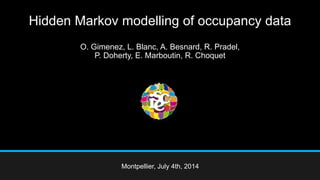My talk at ISEC 2014 (http://isec2014.sciencesconf.org/) on how to model occupancy data using hidden Markov models
- 1. Hidden Markov modelling of occupancy data O. Gimenez, L. Blanc, A. Besnard, R. Pradel, P. Doherty, E. Marboutin, R. Choquet Montpellier, July 4th, 2014
- 4. My conversion to occupancy models ? I’m more of a capture-recapture (CR) guy ? Can we use what we know from CR for occupancy? ? Individuals in CR = Sites in occupancy ? Two sides of same coin: hidden Markov models (HMM) ? Suggested by M. Kéry, I. Fiske, W. Challenger, … ? Flexible framework, well developed in other areas
- 5. Dynamic occupancy models as HMMs O U O = occupied; U = unoccupied extinction e
- 6. Dynamic occupancy models as HMMs 1 O U O = occupied; U = unoccupied 1 = species detected; 0 = species undetected 0 1 extinction e 1-pp p
- 7. Dynamic occupancy models as HMMs 1 O U O = occupied; U = unoccupied 1 = species detected; 0 = species undetected 0 1 0 0 0 1-pp extinction 0 e p 0 0
- 8. Dynamic occupancy models as HMMs 0 U O O = occupied; U = unoccupied 1 = species detected; 0 = species undetected 0 0 1 1 1 colonization g 0 0 0 p p p
- 9. Dynamic occupancy models as HMMs Initial states State process Observation process
- 10. Single-season occupancy models as HMMs ? No colonization (g=0) and no extinction (e=0) – closure assumption
- 11. Single-season occupancy models as HMMs Initial states State process Observation process ? No colonization (g=0) and no extinction (e=0) – closure assumption
- 12. Advantages of the HMM formulation 1. (Almost?) all occupancy models in a unified framework ? Single-season, dynamic models ? Mixtures and random effects (see case study) ? Multistate models, with uncertainty ? Multispecies models ? False-positives (Chambert & Miller, submitted) ? … 2. Formal link between occupancy and CR communities
- 13. E-SURGE and occupancy models ? E-SURGE, software developed to analyze CR data with HMMs Rémi Choquet Roger Pradel
- 14. The E-SURGE of occupancy models
- 15. ? Model specification via user-friendly syntax ? Numerical tools (random effects, identifiability) E-SURGE and occupancy models
- 17. Case study with Eurasian lynx in France ? Signs of presence between 2002 and 2006 ? 197 sites, 5 1-y periods ? Single-season occupancy & detection heterogeneity Van Gogh
- 18. Detection heterogeneity Random effect Finite mixture Royle (2006), Gimenez & Choquet (2010) Pledger et al. (2003), Pradel (2005)
- 19. Results Random effect Finite mixture Average detection probability 0.5 in both models
- 20. Perspectives – based on CR experiences 1. Distribution mapping: unobserved states via Viterbi 2. Accounting for lack of independence: ? Trap-dependence ? Spatial autocorrelation (memory model)
- 21. 厂别濒蹿-辫谤辞尘辞迟颈辞苍…
- 22. Bonus slides
- 24. Model selection in Lynx case study
- 25. Multistate occupancy model - 1
- 26. Multistate occupancy model - 2
- 27. Multistate occupancy model - 3



























